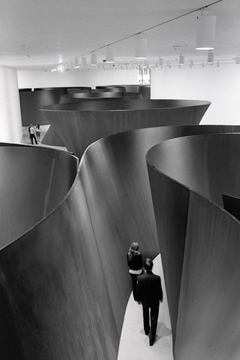
Amid the noise and anxiety of the art fairs (read my review of Scope here), two significant exhibitions by major US artists have opened simultaneously in London: Richard Serra at Gagosian and Robert Irwin at White Cube. The two artists share a number of similarities: California-born (Irwin in 1928, Serra in 1939), emerging from and expanding upon the principles of minimalist sculpture, and experiential in approach (and therefore practically unreproducible in photographs; Irwin famously banned photos of his work for a large part of his career). Each artist has attracted some outstanding writers to their defense: Kirk Varnedoe in Pictures of Nothing embarks on an extended consideration of Serra’s steel ellipses; Lawrence Weschler’s book Seeing is Forgetting the Name of the Thing One Sees traces Irwin’s career to compelling and hugely influential effect. Both shows feel like reminders—to those browbeaten by the last-days-of-Rome extravagance of the art fair crowd—of why contemporary art matters.
Serra’s Gagosian show (for which the floor of the gallery had to be reinforced) consists of four vast steel sculptures: two russet Cor-Ten ellipses, a flat steel ‘wall,’ mottled with rust, and a huge steel ‘maze’ that fills the gallery like a beached whale. The ‘maze’ (entitled Open Ended) sends the viewer through alternately widening and narrowing passages, the walls bulging and contracting like the lungs of a dinosaur. In Serra’s work, viewers are forced into a looping movement that is reminiscent of the artist’s earliest performance works that grew out of Jackson Pollock’s performative abstraction. Yet Serra’s sculptures don’t require any prior knowledge of the artist’s work, or of any artist’s work; the experience itself, a sort of industrial sublime, is accessible and even generous. Standing under a sheet of steel that bulges above your head like a tidal wave, you feel the smallness and the frailty of your own body in a way that thrusts you back to childhood experiences of cliff edges, rollercoasters, and thunderstorms. It’s a primal experience that lights up the dark parts of your memory. I find it amazing that Serra hasn’t yet been, to my knowledge, invited to display work in Tate Modern’s Turbine Hall. Of all artists, his sheets of weathered metal would sit well in its stark factory interior.
Irwin’s show at White Cube is, incredibly, the 80-year-old artist’s first solo exhibition in the UK. Upstairs, two square black lacquered panels on opposite walls of the gallery are separated by numerous ceiling-high sheets of scrim in wooden frames. On each layer, the shape of the square is repeated, so that a kind of rectangular black tunnel appears, suspended in the middle of the space. Walking between the layers, you feel weightless, buoyant; other visitors slip in and out of your vision, so that your eyes and brain get knocked out of sync. It’s like Kazimir Malevich’s Black Square turned three-dimensional, as insubstantial as fog and equally as disorienting. Downstairs, three adjacent walls of the gallery are filled floor-to-ceiling with arrangements of pairs of white fluorescent tubes, set in various combinations of right angles (again apparently an extrapolation of early Modernist utopian art, here recalling El Lissitzky). The piece gives light a physical presence, energizing the space between the walls. Here, as in all of Irwin’s best-known works, the pieces are correctives to indiscriminate looking; the one thing you’re considering is your perception of the piece, not the piece itself.
What both Serra and Irwin manage to do in these shows is to connect our senses of perception inextricably. Contemporary culture’s overabundance of visual data creates a disconnection between looking and thinking–and between looking and seeing. I left both shows feeling enlivened and enlightened, faith restored.